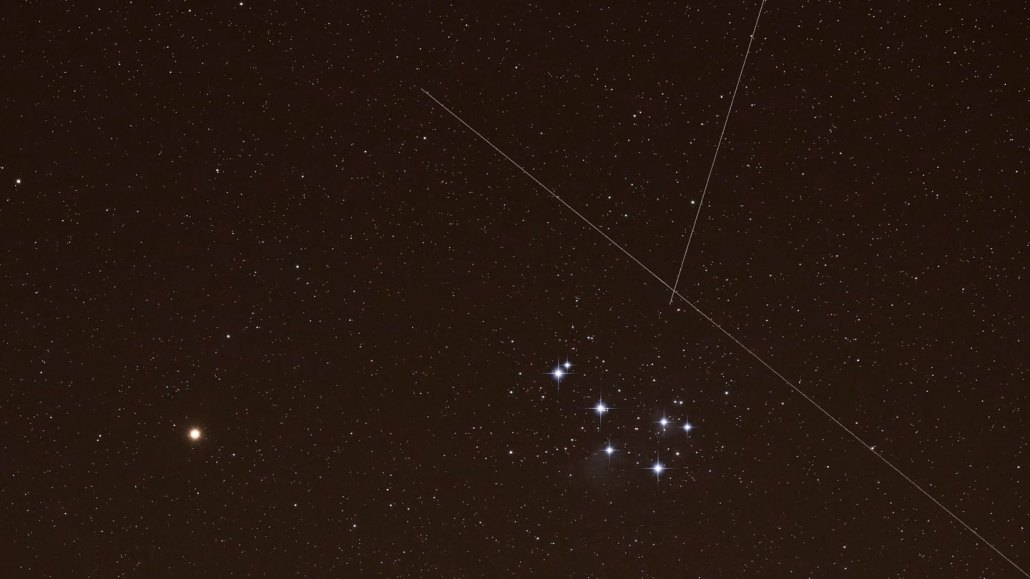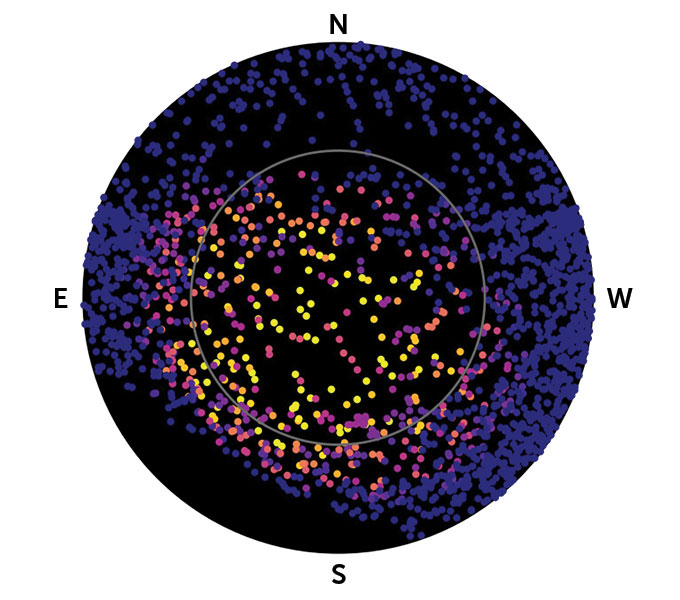
Artificial satellites like SpaceX’s Starlink constellations will leave streaks in photos of the sky taken by researchers and amateur astronomers alike. This photo shows Mars (left) and the Pleiades star cluster with light trails from two Starlinks crisscrossing the scene.
Christophe Lehenaff/Moment/Getty Images Plus
- More than 2 years ago
Fleets of private satellites orbiting Earth will be visible to the naked eye in the next few years, sometimes all night long.
Companies like SpaceX and Amazon have launched hundreds of satellites into low orbits since 2019, with plans to launch thousands more in the works — a trend that’s alarming astronomers. The goal of these satellite “mega-constellations” is to bring high-speed internet around the globe, but these bright objects threaten to disrupt astronomers’ ability to observe the cosmos (SN: 3/12/20). “For astronomers, this is kind of a pants-on-fire situation,” says radio astronomer Harvey Liszt of the National Radio Astronomical Observatory in Charlottesville, Va.
Now, a new simulation of the potential positions and brightness of these satellites shows that, contrary to earlier predictions, casual sky watchers will have their view disrupted, too. And parts of the world will be affected more than others, astronomer Samantha Lawler of the University of Regina in Canada and her colleagues report in a paper posted September 9 at arXiv.org.
“How will this affect the way the sky looks to your eyeballs?” Lawler asks. “We humans have been looking up at the night sky and analyzing patterns there for as long as we’ve been human. It’s part of what makes us human.” These mega-constellations could mean “we’ll see a human-made pattern more than we can see the stars, for the first time in human history.”
Flat, smooth surfaces on satellites can reflect sunlight depending on their position in the sky. Earlier research had suggested that most of the new satellites would not be visible with the naked eye.
Lawler, along with Aaron Boley of the University of British Columbia and Hanno Rein of the University of Toronto at Scarborough in Canada, started building their simulation with public data about the launch plans of four companies — SpaceX’s Starlink, Amazon’s Kuiper, OneWeb and StarNet/GW — that had been filed with the U.S. Federal Communications Commission and the International Telecommunications Union. The filings detailed the expected orbital heights and angles of 65,000 satellites that could be launched over the next few years.
“It’s impossible to predict the future, but this is realistic,” says astronomer Meredith Rawls of the University of Washington in Seattle, who was not involved in the new study. “A lot of times when people make these simulations, they pick a number out of a hat. This really justifies the numbers that they pick.”
There are currently about 7,890 objects in Earth orbit, about half of which are operational satellites, according to the U.N. Office for Outer Space Affairs. But that number is increasing fast as companies launch more and more satellites (SN: 12/28/20). In August 2020, there were only about 2,890 operational satellites.
Next, the researchers computed how many satellites will be in the sky at different times of year, at different hours of the night and from different positions on Earth’s surface. They also estimated how bright the satellites were likely to be at different hours of the day and times of the year.
That calculation required a lot of assumptions because companies aren’t required to publish details about their satellites like the materials they’re made of or their precise shapes, both of which can affect reflectivity. But there are enough satellites in orbit that Lawler and colleagues could compare their simulated satellites to the light reflected down to Earth by the real ones.
The simulations showed that “the way the night sky is going to change will not affect all places equally,” Lawler says. The places where naked-eye stargazing will be most affected are at latitudes 50° N and 50° S, regions that cross lower Canada, much of Europe, Kazakhstan and Mongolia, and the southern tips of Chile and Argentina, the researchers found.

“The geometry of sunlight in the summer means there will be hundreds of visible satellites all night long,” Lawler says. “It’s bad everywhere, but it’s worse there.” For her, this is personal: She lives at 50° N.
Closer to the equator, where many research observatories are located, there is a period of about three hours in the winter and near the time of the spring and fall equinoxes with few or no sunlit satellites visible. But there are still hundreds of sunlit satellites all night at these locations in the summer.
A few visible satellites can be a fun spectacle, Lawler concedes. “I think we really are at a transition point here where right now, seeing a satellite, or even a Starlink train, is cool and different and wow, that’s amazing,” she says. “I used to look up when the [International Space Station] was overhead.” But she compares the coming change to watching one car go down the road 100 years ago, versus living next to a busy freeway now.
“Every sixteenth star will actually be moving,” she says. “I hope I’m wrong. I’ve never wanted to be wrong about a simulation more than this. But without mitigation, this is what the sky will look like in a few years.”
Astronomers have been meeting with representatives from private companies, as well as space lawyers and government officials, to work out compromises and mitigation strategies. Companies have been testing ways to reduce reflectivity, like shading the satellites with a “visor.” Other proposed strategies include limiting the satellites to lower orbits, where they move faster across the sky and leave a fainter streak in telescope images. Counterintuitively, lower satellites may be better for some astronomy research, Rawls says. “They move out of the way quick.”
But that lower altitude strategy will mean more visible satellites for other parts of the world, and more that are visible to the naked eye. “There’s not some magical orbital altitude that solves all our problems,” Rawls says. “There are some latitudes on Earth where no matter what altitude you put your satellites at, they’re going to be all over the darn place. The only way out of this is fewer satellites.”
There are currently no regulations concerning how bright a satellite can be or how many satellites a private company can launch. Scientists are grateful that companies are willing to work with them, but nervous that their cooperation is voluntary.
“A lot of the people who work on satellites care about space. They’re in this industry because they think space is awesome,” Rawls says. “We share that, which helps. But it doesn’t fix it. I think we need to get some kind of regulation as soon as possible.” (Representatives from Starlink, Kuiper and OneWeb did not respond to requests for comment.)
Efforts are under way to bring the issue to the attention of the United Nations and to try to use existing environmental regulations to place limits on satellite launches, says study coauthor Boley (who also lives near 50° N).
Analogies to other global pollution problems, like space junk, can provide inspiration and precedents, he says. “There are a number of ways forward. We shouldn’t just lose hope. We can do things about this.”







